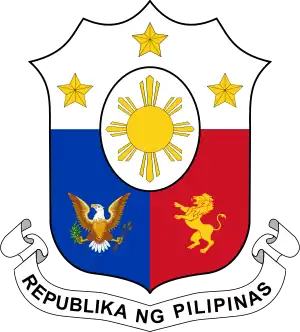National Living Treasures Award (Philippines)
The National Living Treasures Award, alternatively known as the Gawad sa Manlilikha ng Bayan (GAMABA; lit. 'Award for the Creators of the Country'), is conferred to a person or group of artists recognized by the Government of the Philippines for their contributions to the country's intangible cultural heritage. A recipient of the award, a National Living Treasure or Manlilikha ng Bayan is "a Filipino citizen or group of Filipino citizens engaged in any traditional art uniquely Filipino, whose distinctive skills have reached such a high level of technical and artistic excellence and have been passed on to and widely practiced by the present generations in their community with the same degree of technical and artistic competence."[1]
| National Living Treasure Award Gawad sa Manlilikha ng Bayan | |
|---|---|
 Award logo | |
| Awarded by | |
| Type | Medal |
| Awarded for | See Award |
| Status | Currently constituted |
| Sovereign | President of the Philippines |
| Statistics | |
| First induction | 1993 |
| Precedence | |
| Next (higher) | Order of Gabriela Silang |
| Next (lower) | Gawad Mabini |
| Equivalent | Order of National Artists, Order of National Scientists, Order of National Social Scientists, Order of Lakandula - Special Class of Champion for Life |
Ribbon bar of the order | |

History
In 1988, the National Folk Artists Award was organized by the Rotary Club of Makati-Ayala. The distinctions were given by the organization until it was replaced by the GAMABA Law in 1992. The recipients of the National Folk Artists from 1988-1992 are not recognized by the government as the award was given by a private organization.[2]
The National Living Treasures Award (Gawad sa Manlilikha ng Bayan) was institutionalized in 1992 through Republic Act No. 7355. The National Commission for Culture and the Arts, which is the highest policy-making and coordinating body of the Philippines for culture and the arts, was tasked with the implementation and awarding.[3] This is in line with UNESCO's criteria of Living National Treasures.
Criteria
To become a National Living Treasure, the candidate must possess the following qualifications:[3]
- is an inhabitant of an indigenous/traditional cultural community anywhere in the Philippines that has preserved indigenous customs, beliefs, rituals and traditions and/or has syncretized whatever external elements that have influenced it.
- must have engaged in a folk art tradition that has been in existence and documented for at least 50 years.
- must have consistently performed or produced over a significant period, works of superior and distinctive quality.
- must possess a mastery of tools and materials needed by the art, and must have an established reputation in the art as master and maker of works of extraordinary technical quality.
- must have passed on and/or will pass on to other members of the community their skills in the folk art for which the community is traditionally known.
A traditional artist who possesses all the qualities of a Manlilikha ng Bayan candidate, but due to age or infirmity has left them incapable of teaching further their craft, may still be recognized if:[3]
- had created a significant body of works and/or has consistently displayed excellence in the practice of their art, thus achieving important contributions for its development.
- has been instrumental in the revitalization of their community's artistic tradition.
- has passed on to the other members of the community skills in the folk art for which the community is traditionally known.
- community has recognized them as master and teacher of their craft.
Categories
The categories are, but not limited to, the following categories of traditional folk arts:[3]
- ethnomedicine
- folk architecture
- maritime transport
- weaving
- carving
- performing arts
- literature
- graphic and plastic arts
- ornament
- textile or fiber arts
- pottery.
- architecture
Other artistic expressions of traditional culture may be added, such as the case of the ethnomedicine category, which was added only in 2020.[4]
Recipients
As defined by UNESCO, the bearers of intangible cultural heritage are to be known internationally as Living Human Treasures. The Filipino counterparts of this title are the Gawad sa Manlilikha ng Bayan (GAMABA) awardees. There are currently sixteen declared GAMABA awardees, all of which have exemplified the highest standard in their respective field of expertise.
Recipients
- Ginaw Bilog (d. 2003), artist and poet, Mansalay, Oriental Mindoro Poetry (Ambahan), December 17, 1993[5][6]
- Masino Intaray (d. 2013), musician and epic chanter, Brooke's Point, Palawan, Poetry (Kulilal and Bagit) and Music (Basal / Gong), 1993[7]
- Samaon Sulaiman (d. 2011), musician, Mamasapano, Maguindanao Music (Kutyapi), 1993[8]
- Lang Dulay, (d. 2015) textile weaver, Lake Sebu, South Cotabato, Weaving (T’nalak), 1998[9]
- Salinta Monon (d. 2009), weaver, Bansalan, Davao del Sur, Weaving (Abaca – ikat / Inabal), 1998[10]
- Alonzo Saclag, musician and dancer, Lubuagan, Kalinga, Music and Dance (Kalinga), 2000[11]
- Federico Caballero, epic chanter, Sulod- Bukidnon, Iloilo, Poetry and Epic Chant (Sugidanon), 2000[12]
- Uwang Ahadas, (d. 2022), musician, Lamitan, Basilan, Music (Yakan specifically Kulintang, kwitangan kayu, gabbang, agung, and tuntungan), 2000[13]
- Darhata Sawabi, (d. 2005), weaver, Parang, Sulu, Weaving (Pis Syabit), 2004[14]
- Eduardo Mutuc, metalsmith / metal sculptor, Apalit, Pampanga, Metalwork (Bronze and Silver), 2004[15]
- Haja Amina Appi (d. 2013), weaver, Tandubas, Tawi-Tawi, Weaving (Mat), 2004[16]
- Teofilo Garcia, casque maker, San Quintin, Abra, Casque Making (Tabungaw), 2012[17]
- Magdalena Gamayo, master weaver, Pinili, Ilocos Norte, Weaving (Inabel), 2012[18]
- Ambalang Ausalin (d. 2022), master weaver, Lamitan, Basilan, Weaving (Yakan tennun), 2016[19]
- Estelita Tumandan Bantilan, master weaver, Malapatan, Sarangani, Weaving (B'laan igem), 2016[20]
- Yabing Masalon Dulo (d. 2021), master weaver, Polomolok, South Cotabato, Weaving (Ikat), 2016[21]
See also
References
- Executive Order No. 236, s. 2003 Official Gazette of the Republic of the Philippines. Retrieved 14 April 2013.
- "GAMABA: Gawad sa Manlilikha ng Bayan". National Commission for Culture and the Arts. Retrieved September 15, 2021.
- "Briefer: Gawad sa Manlilikha ng Bayan". Official Gazette of the Republic of the Philippines. Archived from the original on January 12, 2015. Retrieved August 28, 2016.
- Pag-iwayan, J. (2020). Albularyo, babaylan, and manghihilot are now considered national living treasures. Manila Bulletin.
- "GAMABA: Ginaw Bilog". Ncca.gov.ph. Retrieved December 14, 2019.
- Postma, Antoon (1995). "THE AMBAHAN: A MANGYAN POEM OF MINDORO". Philippine Quarterly of Culture and Society. 23 (1): 44–61. ISSN 0115-0243. Retrieved September 15, 2021.
- "GAMABA: Masino Intaray". Ncca.gov.ph. Retrieved December 14, 2019.
- "GAMABA: Samaon Sulaiman". Ncca.gov.ph. Retrieved December 14, 2019.
- "GAMABA: Lang Dulay". Ncca.gov.ph. Retrieved December 14, 2019.
- "National Living Treasures: Salinta Monon - National Commission for Culture and the Arts". Ncca.gov.ph. Retrieved December 14, 2019.
- "GAMABA: Alonzo Saclag". Ncca.gov.ph. Retrieved December 14, 2019.
- "GAMABA: Federico Caballero". Ncca.gov.ph. Retrieved December 14, 2019.
- "GAMABA: Uwang Ahadas". Ncca.gov.ph. Retrieved December 14, 2019.
- "GAMABA: Darhata Sawabi". Ncca.gov.ph. Retrieved December 14, 2019.
- "GAMABA: Eduardo Mutuc". Ncca.gov.ph. Retrieved December 14, 2019.
- "GAMABA: Haja Amina Appi". Ncca.gov.ph. Retrieved December 14, 2019.
- "GAMABA: Teofilo Garcia". Ncca.gov.ph. Retrieved December 14, 2019.
- "GAMABA: Magdalena Gamayo". Ncca.gov.ph. Retrieved December 14, 2019.
- "National Living Treasures: Ambalang Ausalin - National Commission for Culture and the Arts". Ncca.gov.ph. March 4, 1943. Retrieved December 14, 2019.
- "Manlilikha ng Bayan - Estelita Bantilan". Ncca.gov.ph. October 17, 1940. Retrieved December 14, 2019.
- "National Living Treasures: Yabing Masalon Dulo - National Commission for Culture and the Arts". Ncca.gov.ph. August 8, 1914. Retrieved December 14, 2019.
